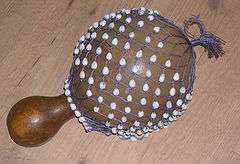Shekere

The shekere is an instrument from West Africa consisting of a dried gourd with beads woven into a net covering the gourd. Throughout the continent there are similar gourd/bead or gourd/seed percussion instruments. Some are the lilolo, axatse (Ghana), djabara (Guinea), ushàkà, chequere and saa saa (Liberia). It is predominantly called shekere in Nigeria.
The Agbe is a gourd drum with cowrie shells and is usually strung with white cotton thread. The Axatse is a small gourd, held by the neck and percussed between hand and leg. In Liberia, the net has a long "tail" through which the beads are manipulated.
The shekere is made from vine gourds that grow on the ground. The shape of the gourd determines the sound of the instrument. A shekere is made by drying the gourd for several months then removing the pulp and seeds. After it is scrubbed, skillful bead work is added as well as colour.
The instrument is used for folkloric traditions as well as some of the popular music styles. In performance it is shaken and/or hit against the hands.
In Cuba the chekeré (always spelt thus) is also known as aggué (abwe) or simply guiro (a word that means 'gourd', though not to be confused with a different percussive instrument, more specifically known as a guiro worldwide, the latter being "raked" with a stick, and common, for instance in Salsa and Cumbia). The chekeré is a large, hollow gourd (~50 cm long, approx. 19 1⁄2 in) almost entirely surrounded by a network of cords, to which many coloured beads are attached. Widely used in Afro-Cuban sacred and popular music, it may be twisted, shaken or slapped producing a subtle variety of effects; musically, it is more flexible than maracas. [1][2]
In Brazil, this African gourd rattle is called a xequerê. It consists of the gourd (cabaça) cut in the middle and then wrapped in a net in which beads or small plastic balls are threaded. The afoxé is a similar, smaller instrument.
 |
Shekere
Basic groove on shekere |
| Problems playing this file? See media help. | |
See also
References
- ↑ Orovio, Helio 2004. Cuban music from A to Z. p52
- ↑ Ortiz, Fernando 1952. Los instrumentos de la musica Afrocubana. 5 volumes, La Habana, vol 2, p124.